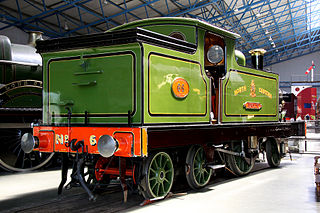Related Research Articles
John George Robinson CBE, was an English railway engineer, and was chief mechanical engineer of the Great Central Railway from 1900 to 1922.

In Whyte notation, a 2-2-4T is a steam locomotive that has two leading wheels followed by two coupled driving wheels and four trailing wheels. This was an unusual wheel arrangement, only used on a few specialised locomotives. This wheel arrangement is only used for tank locomotives.

The Metropolitan Railway K Class consisted of six 2-6-4T steam locomotives, numbered 111 to 116.

The North Eastern Railway (NER) Class H, classified as Class Y7 by the London and North Eastern Railway (LNER) is a class of 0-4-0T steam locomotives designed for shunting.

Stephen Dewar Holden was a British engineer, the son of the engineer James Holden and succeeded his father as locomotive superintendent of the Great Eastern Railway in 1908, a post he held until his retirement in 1912.

The GER Class T18 was a class of fifty 0-6-0T steam locomotives designed by James Holden for the Great Eastern Railway. They passed to the London and North Eastern Railway at the grouping in 1923 and received the LNER classification J66.

The first London and North Eastern Railway (LNER) Class A2 was a class of 4-6-2 steam locomotive designed by Vincent Raven for the North Eastern Railway. Two were built by the NER in 1922 before the grouping and another three by the LNER in 1924. Their LNER numbers were 2400–2404. All five locomotives were named by the LNER.
Thomas Wheatley (1821–1883) was an English mechanical engineer who worked for several British railway companies and rose to become a Locomotive Superintendent at the London and North Western Railway (LNWR) and the North British Railway (NBR).

The NER 901 Class was a class of 2-4-0 steam locomotive of the North Eastern Railway, designed by Edward Fletcher. Between 1872 and 1882 55 of the class were built for the NER.

The NER Class X was a class of 4-8-0T tank locomotive designed by Wilson Worsdell for the North Eastern Railway. They were intended for use as powerful shunting engines to arrange and move coal wagons for loading into ships. In total 15 were built, 10 by the NER between 1909 and 1910, and a further five in 1925 by the London and North Eastern Railway (LNER). They had three cylinders with divided drive: the inside cylinder driving the leading axle, the outside cylinders driving the centre.

The Class EF1 was a class of electrically powered locomotives built by the North Eastern Railway from 1914. They were built to haul coal trains from the mines at Shildon to the docks at Middlesbrough. In common with other LNER electric locomotives, no classification was given to these locomotives until 4 October 1945, when nos. 3-12 were all classified EB1 although only no. 11 was actually modified for banking. It was expected that all the locomotives would be similarly modified, but this did not happen, and the remaining locos were classified as EF1.

The North Eastern Railway Class S was a 4-6-0 type of steam locomotive designed for express passenger workings. The first example was built in 1899. They were very similar to the NER Class S1, except for the smaller wheels of the former.
The NER Class W1 was a 4-6-2T steam locomotive of the North Eastern Railway. The class was introduced in 1914 as a rebuild of Wilson Worsdell's NER Class W 4-6-0T. At the 1923 Grouping, they all passed to the London and North Eastern Railway, who placed them in their Class A6.
The LNER Class J64 was a class of three 0-6-0T steam locomotives of the London and North Eastern Railway.
The NER 38 Class was a class of 4-4-0 steam locomotives designed by Alexander McDonnell for the North Eastern Railway. Twenty-eight were built in 1884–5, and remained in service until 1915–23.
Ken Hoole (1916–1988) was an English historian known for his works on the railways of the north east of England.
The North Eastern Railway was formed by merger in 1854 and merged into the London and North Eastern Railway at the grouping in 1923. Between those dates five men held the post of Locomotive Superintendent.

The Great Northern Railway Class A1 1470 Great Northern was the first of 52 A1 class locomotives. It has also represented three distinct stages in the history of the British 4-6-2 "Pacific" steam locomotives designed by Nigel Gresley for the Great Northern Railway (GNR), a constituent company of the London and North Eastern Railway before the amalgamation of 1923, for which they became a standard design. Eventually Great Northern was completely rebuilt as Class A1/1.
The NER Class W was a class of ten 4-6-0T locomotives built by the North Eastern Railway at their Gateshead Works between 1907 and 1908. They were all rebuilt as Class W1 4-6-2T locomotives between 1914 and 1917.
References
- ↑ "Alexander McDonnell". steamindex.com.
- 1 2 "LNER Encyclopedia: Alexander McDonnell". www.lner.info.
- 1 2 Boddy, M.G.; Fry, E.V.; Hennigan, W.; Proud, P.; Yeadon, W.B. (July 1963). Fry, E.V. (ed.). Part 1: Preliminary Survey. Locomotives of the L.N.E.R. Potters Bar: RCTS. pp. 10, 11.
- 1 2 Fry, E.V.; Hoole, Ken; Manners, F.; Neve, E.; Proud, P.; Yeadon, W.B. (August 1981). Fry, E.V. (ed.). Part 3C: Tender Engines – Classes D13 to D24. Locomotives of the L.N.E.R. Kenilworth: RCTS. pp. 56–57. ISBN 0-901115-52-5.
- ↑ Fry, E.V., ed. (September 1966). Part 5: Tender Engines – Classes J1 to J37. Locomotives of the L.N.E.R. Kenilworth: RCTS. p. 145. ISBN 0-901115-12-6.
- ↑ "LNER Encyclopedia: The McDonnell NER Class '38' 4-4-0 Locomotives". www.lner.info.
- ↑ "LNER Encyclopedia: The McDonnell J22 (NER Class '59') 0-6-0 Locomotives". www.lner.info.